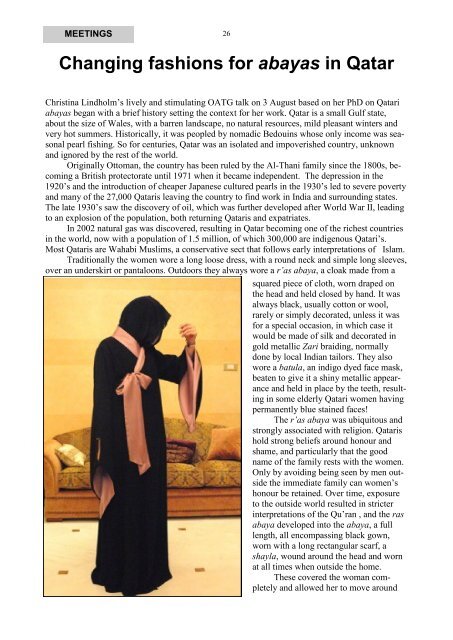MEETINGS26Changing fashions for abayas in QatarChristina Lindholm‘s lively and stimulating <strong>OATG</strong> talk on 3 August based on her PhD on Qatariabayas began with a brief history setting the context for her work. Qatar is a small Gulf state,about the size of Wales, with a barren landscape, no natural resources, mild pleasant winters andvery hot summers. Historically, it was peopled by nomadic Bedouins whose only income was seasonalpearl fishing. So for centuries, Qatar was an isolated and impoverished country, unknownand ignored by the rest of the world.Originally Ottoman, the country has been ruled by the Al-Thani family since the 1800s, becominga British protectorate until 1971 when it became independent. The depression in the1920‘s and the introduction of cheaper Japanese cultured pearls in the 1930‘s led to severe povertyand many of the 27,000 Qataris leaving the country to find work in India and surrounding states.The late 1930‘s saw the discovery of oil, which was further developed after World War II, leadingto an explosion of the population, both returning Qataris and expatriates.In 2002 natural gas was discovered, resulting in Qatar becoming one of the richest countriesin the world, now with a population of 1.5 million, of which 300,000 are indigenous Qatari‘s.Most Qataris are Wahabi Muslims, a conservative sect that follows early interpretations of Islam.Traditionally the women wore a long loose dress, with a round neck and simple long sleeves,over an underskirt or pantaloons. Outdoors they always wore a r’as abaya, a cloak made from asquared piece of cloth, worn draped onthe head and held closed by hand. It wasalways black, usually cotton or wool,rarely or simply decorated, unless it wasfor a special occasion, in which case itwould be made of silk and decorated ingold metallic Zari braiding, normallydone by local Indian tailors. They alsowore a batula, an indigo dyed face mask,beaten to give it a shiny metallic appearanceand held in place by the teeth, resultingin some elderly Qatari women havingpermanently blue stained faces!The r’as abaya was ubiquitous andstrongly associated with religion. Qatarishold strong beliefs around honour andshame, and particularly that the goodname of the family rests with the women.Only by avoiding being seen by men outsidethe immediate family can women‘shonour be retained. Over time, exposureto the outside world resulted in stricterinterpretations of the Qu‘ran , and the rasabaya developed into the abaya, a fulllength, all encompassing black gown,worn with a long rectangular scarf, ashayla, wound around the head and wornat all times when outside the home.These covered the woman completelyand allowed her to move around
outdoors without attracting the unwanted attention of men.Unadorned, this garment remained little changed in style untilthe 1970‘s when exposure to the outside world led to a moresecular society and the adoption of western dress by somewomen.However, the late 1980‘s saw an increase in Islamismand women adopting the abaya again and by the late 1990‘sthey were worn by all women, but in a more modern form.This abaya is more like an outer dress or light coat pulledover the head, worn with a shayla and sometimes a niqab, acloth veil to cover their faces. Again, wearing them wasclosely linked with beliefs of Islam and family honour, althoughnowhere in the Qu‘ran does it say women must becovered.By this time many Qatari women were wealthy, welleducated, widely travelled career women, and like all fashionablewomen, they were keen to express individuality andmodernity through their dress. They didn‘t however, feel theneed to adopt western dress, instead choosing to retain the27 MEETINGSabaya as an expression of their beliefs and as a means of showing their wealth and modernity.Nowadays it comes in many forms and women will have many different abayas for differentuses - casual ones for work and play, more ornate ones for social occasions. They can be veryelaborate, often reflection other cultures, such as kimonos, and containing beading, detailed embroideryand cutwork. Sleeves became a feature – sometimes very long and decorated, sometimespuffed and beaded and shayla’s often have matching embroidery.Also, they are no longer restricted to garments that pull over the head, covering allundergarments. Some are open down the front, held in place by merely a clasp, and revealing the(often European) fashions worn underneath. Decoration is no longer restricted to the front necklineand can now be seen on all parts of the garment and often incorporating logos from westernfashion houses. The most elaborate garments can cost many thousands of dollars.This notion of them as fashion spread and in 2009 an Haute Couture Abayas show was heldin the George V Hotel in Paris where the British designer Bruce Oldfield showed an abaya withbraided diamond borders worth £177,000.Although widely worn inside the country still, many Qatari women discard them whentravelling abroad, preferring instead to wear western designer clothes.Having taken us through a fascinating historical journey of Qatari abayas from religioussymbol to disposable fashion garment, Christina raised the question of why this change has comeabout. Far from taking women out of the gaze of others, they are now designed to attract attention.So what is happening? Why have their clothes become more elaborate and fashion statements?There is a number of possible answers. Women are not longer isolated and have becomeaware of clothes as ‗fashion‘; all Qatari women are now educated and can read for themselves, discoveringthat the Qu‘ran doesn‘t say they should wear black robes, just that they should be modestlydressed; the Emir of Qatar‘s favourite wife, often photographed in fashion magazines andnewspapers, is a powerful role model for showing the world that Qatari women are modern, fashionableand sophisticated; or perhaps, like the Victorians, they now have wealth of their own andthey use dress as an expression of that wealth.Exactly which of these reasons has driven the change is not clear. And how will this be inthe future? Will the abaya be a statement of fashionable, independent attire, a folk dress or a symbolof religious beliefs? Only time will tell.Anne O’Dwyer
















